![]() 1st Battalion 22nd Infantry
1st Battalion 22nd Infantry ![]()
Early Frontier Service of the 22nd Infantry
1866 - 1873
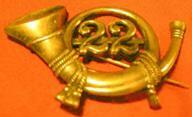 -------------
-------------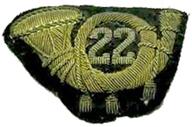
Cap insignia for the 22nd Infantry
Regiment authorized for wear 1872-1875
----Left,
metal pin-on for enlisted------Right, bullion sew-on for officer
( Ed. note: in 1815, after the
War of 1812, the 22nd Infantry Regiment was inactivated.
It was not reactivated until 1866, when the 2nd Battalion of the
13th Infantry was re-designated
as the US 22nd Regiment of Infantry.)
RE-ACTIVATION OF THE TWENTY-SECOND INFANTRY
The organization of the Second Battalion,
Thirteenth Infantry, did not commence until 1863;
Companies A and B being organized at Camp Dennison, Ohio, in May
of that year,
while Companies C, D, E, F, G and H did not appear as units until
July, 1865.
A month later the entire battalion left Camp Dennison for
Jefferson Barracks, Missouri, where it arrived on September 5.
In November of the same year the battalion went to Fort Larned by
way of Fort Leavenworth, Kansas.
In May, 1866, the Second Battalion was concentrated at Fort
Leavenworth,
and proceeded thence to the District of the Upper Missouri.
In this District stations were taken by units of the battalion as
follows:
Headquarters and Companies A and B, Fort Randall;
Companies C, E and H, Fort Sully;
Company G, Fort Thompson ;
Company F. Fort James;
Company D, Fort Dakota.
Organization of the Twenty-second Infantry
September 21, 1866, in pursuance of the Act of
Congress of July 28, 1866,
the designation of the Second Battalion, Thirteenth Infantry, was
changed to the Twenty-second Regiment of Infantry,
which title the regiment has borne to the present day.
The first Colonel of the Twenty-second was David S. Stanley, who
commanded the regiment for eighteen years,
until he was appointed a Brigadier-General in 1884. Colonel
Stanley died March 13, 1902.
Other field officers of the original command were Elwell S. Otis
and Hiram Dryer;
the former eventually became the first American Governor-General
of thePhilippine Islands,
and Major Dryer died while holding that rank in the regiment in
1867.
The regiment at this time consisted of eight letter companies,
this having been the prescribed organization of infantry
regiments
prior to 1866. On October 2, 1866, Companies I and K were
organized at Bedloes Island, New York,
and left the same day to take station at Fort Randall.
The Field Grade Officers of the 22nd Infantry in 1866:
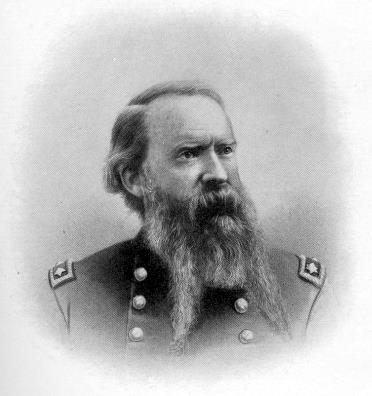
Colonel D.S. Stanley
First Commander of the 22nd Infantry Regiment after its
reactivation in 1866
Portrait done after he attained the rank of Major General.
Illustration from the 1922 Regimental History
Lieutenant Colonel Elwell S. Otis Photo from the New
York |
-------------------------- |
Major Hiram Dryer Photo from the Company K
Fourth Regiment |
Consolidation of the Twenty-second and Thirty-first Regiments
May 15, 1869, the Thirty-first Infantry was
consolidated with the Twenty-second,
the former regiment having been originally the Third Battalion of
the Thirteenth.
On this occasion one-half the officers of the Thirty-first and
all the enlisted personnel were transferred to the Twenty-second
Infantry.
The consolidation of the two regiments was effected by first
combining the companies of the Twenty-second;
Companies A and I becoming Company A;
B and K Company B;
C and F Company C;
D and E Company D;
H retaining its letter designation.
In the same manner Companies B and E of the Thirty-first became
Company E of the Twenty-second;
F and H Company F;
C and G Company G;
D and I Company I;
A and K Company K.
Forty-two years following this consolidation
the Twenty-second Infantry was continuously engaged
in the construction of buildings for small posts in the Indian
country of the West.
In 1870, Regimental Headquarters and Companies A, E, F, and H
occupied Fort Sully;
while Companies B, C, D, and G took station at Fort Randall under
the Lieutenant Colonel.
At the same time Company I was sent to the Crow Creek Indian
Agency,
and K to Lower Brule Agency, these two posts being on opposite
sides of the Missouri River,
about eight miles apart, and midway between Forts Sully and
Randall.
Company I remained at Crow Creek only nine months, after which it
was transferred to Sully
and the Crow Creek buildings were turned over to the Indians to
be used as school houses.
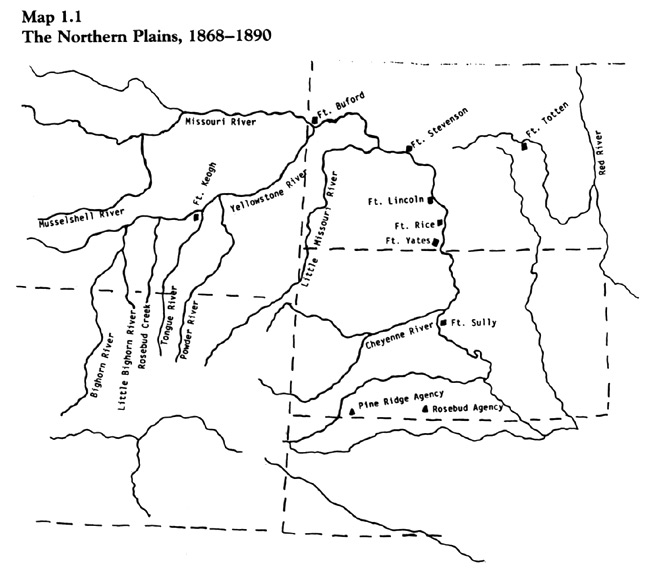
Map of the Northern Plains, from Combat Diary by A.B. Feuer*
1866
Company C was sent to
Fort Buford—which at that time was nothing more than a tent
camp with seventy enlisted men and two officers.
Captain W. G. Rankin's orders were to 'build a post.' The army
was unconcerned that the only tools the men had to work with were
hand-axes,
but that was the least of Rankin's troubles—hostile Indians
attacked the campsite practically every day.
Squads of soldiers, cutting and rafting logs from the mouth of
the Yellowstone River, were often pounced upon and driven back to
camp.
The ensuing battles would last from two to six hours.
Captain Robert Lee Hamilton wrote: "These were trying times
for the small detachment of soldiers at Fort Buford.
The Sioux had been heavily reinforced, and boldly boasted that
they intended to annihilate the soldiers.
Throughout the harsh winter, the post was continually besieged.
The troops were virtually cut off from water [Missouri River]
and were forced to sink wells near their quarters.
Until spring, only two mails managed to leave the fort, and
rumors spread east that the garrison had been massacred.
Captain Rankin's wife spent the winter in camp with her
husband—bravely enduring the hardship and danger."
By the summer of 1867, two more posts were under
construction— Fort Stevenson and Fort Totten.
Working squads carried their guns with them, and, when surprised
by Indians, they would form a battle line and fight off the
warriors.
Large building logs were scarce—at times many miles from the
fort site. Armed escorts were sent with the wagons that carried
the logging parties.
However, they were often attacked by the Sioux—both sides
suffering heavy casualties.
Captain Hamilton stated: "The troops lived in tents until
late in the winter of 1867.
The snow was waist deep before they were able to move into warm
quarters.
"It was none too soon at Stevenson and Totten, as a furious
snow-storm lashed the forts for several days with savage winds,
followed by bitter cold. Officers and men remained inside their
quarters until the storm abated.
At Stevenson, fuel ran out and the soldiers burned furniture to
keep from freezing.
"A wagon train,
loaded with lumber and canned goods, en route from Fort
Abercrombie to Totten,
was forced to halt at the Cheyenne River. In order to keep from
freezing and starving, the men burned the lumber and ate most of
the canned food."
Official correspondence and mail arrived at the forts every two
weeks during the winter—once a month at more distant posts.
The mail was carried by dog sled, and half-breeds were employed
as drivers.
Captain Hamilton narrated: "Communication between Stevenson
and Buford—and between Totten and Stevenson was difficult.
This section of territory was infested with hostile
Indians—who would attack the mail parties and wipe them out
to the man.
"In the Spring of 1868, a squad of soldiers left Totten with
dispatches for Stevenson. About midway between the two posts,
the troops were ambushed by a large number of Sioux. A rescue
party later found the soldiers' bodies—stripped of clothing
and mutilated."*
On June 10, the same year, Captain Albert M.
Powell, a brave and accomplished officer of the regiment,
who rendered good service during the war as chief of artillery of
the 7th army corps, was killed by being thrown from a vicious
horse.
(Website ed., Note: Powell is listed in the 1904 22nd Infantry
Regimental history as an officer of the 22nd Infantry, being one
of the earliest deaths in the Regiment.
However, Powell was a member of the 31st Infantry at the time of
his death and is listed as died on duty with the 31st Infantry in
the Return of the 31st Infantry
for the month of June 1868. The 31st Infantry was not
consolidated with the 22nd Infantry until September 1869 or a
little over a year after Powell died.)
In the meantime the 22nd was building Forts
Sully and Rice and repairing and adding new buildings to Fort
Randall under difficulties similar
to those above recited. Detachments also occupied Indian
agencies, where they had to build shelter. All of the posts were
from time to time
attacked by Indians. In the summer of 1868, a large number of
Sioux Indians attacked the guard with the cattle herd at Buford.
The guard, including two or three officers who joined it on
horseback, fought desperately, but were overpowered,
Lieutenant Cusick being wounded and several men killed or
wounded, and the cattle stampeded and driven off.
This was so sudden and the work so quickly done that the infantry
could not get on the ground in time to take part in it.
Lieutenant Hogan followed the Indians with men in wagons (there
were only enough horses at the post for a small detachment),
and had some skirmishing with them, but could not recapture the
cattle.
On September 26, 1868, detachments from
companies A, B, I and K are recorded as having fought
in an engagement with Sioux Indians, near Ft. Rice, Dakota.
In 1869 the following engagements with Sioux were recorded by the 22nd Regiment:
March 16, near Ft. Randall, Dakota. Detachments
of C and F Companies.
August 3, Ft. Stevenson, Dakota. - Companies E and F, Capt. S.A.
Wainwright in command. Attack on herd.
August 5, Ft. Stevenson, Dakota. - Garrison of post and
Detachment of scouts. Lieut. F.E. Parsons in command. Co. R of
the Scouts. Attack on herd.
During this period, on
the frontier, there was not one mile of railway in the Dakotas
and Montana—
and not more than three stage lines operated in the two
territories. Captain Hamilton wrote how difficult it was to
travel from one post
to another without a military escort: "In 1870, three
officers of the Twenty-second Infantry were ordered from Fort
Sully to Fort Totten—
a distance, as the crow flies, of 250 miles. They were required
to travel by way of Sioux City, Chicago, and St. Paul—
more than 1,600 miles to reach their destination."*
On June 14, 1871 detachments of Companies B, D,
G, H and K fought an engagement with Sioux
near the Ponca Agency, Dakota.
EARLY FRONTIER SERVICE
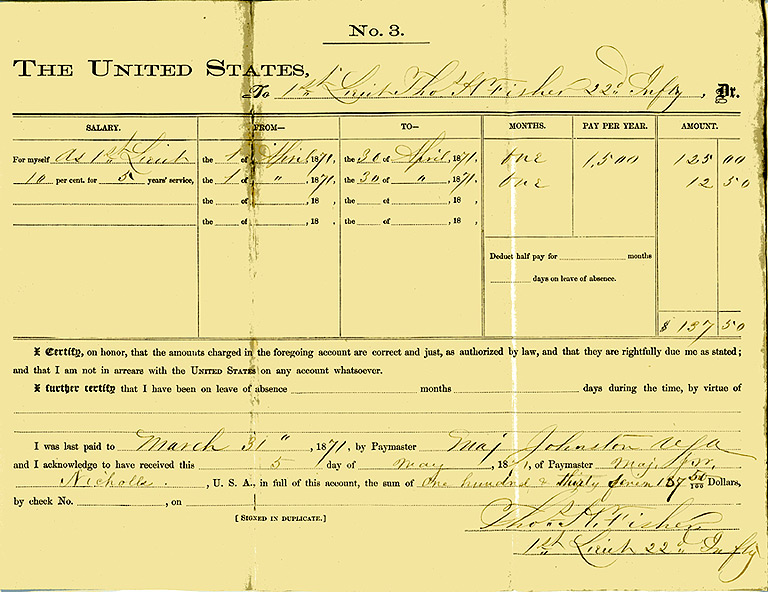
Pay voucher for 1st Lieutenant Thomas
H. Fisher, 22nd Infantry,
for the month of April 1871. His pay included his regular salary
of $125.00 per month.
plus 10 % for 5 years service, giving a final amount of $137.50
pay for the month of April.
The First Yellowstone Expedition
In the Autumn of 1871 the first expedition to
the Yellowstone River was organized at Fort Rice
as an escort to General Thomas Lafayette Rosser's surveying party
along the projected Northern Pacific Railway.
(General Thomas Lafayette
Rosser was a Confederate Major General during the American Civil
War, later a railroad construction engineer
for the Northern Pacific Railroad and the Canadian Pacific
Railroad, and in 1898 a Brigadier General of Volunteers in the
United States Army
during the Spanish–American War. -- Information about
General Rosser provided courtesy of his great great grandson
Douglass C. Cohran Jr.)
The expedition consisted of Companies A, C, H
and I, Twenty-second Infantry; D and H of the Seventeenth ;
B of the Twentieth; two Gatling guns, 26 Indian Scouts and 104
wagons.
The column left Fort Rice September 9, 1871; reached the
Yellowstone River at the mouth of Glendive Creek October 2,
and returned to Fort Rice on October 16, after marching over six
hundred miles.
( Ed. note: on the return trip to Fort Rice, the expedition covered the 300 miles distance in 14 days, 4 days of which were spent resting at campsites.)*
Upon arrival at Fort Rice the units of the expedition were returned to their various posts by steamer.
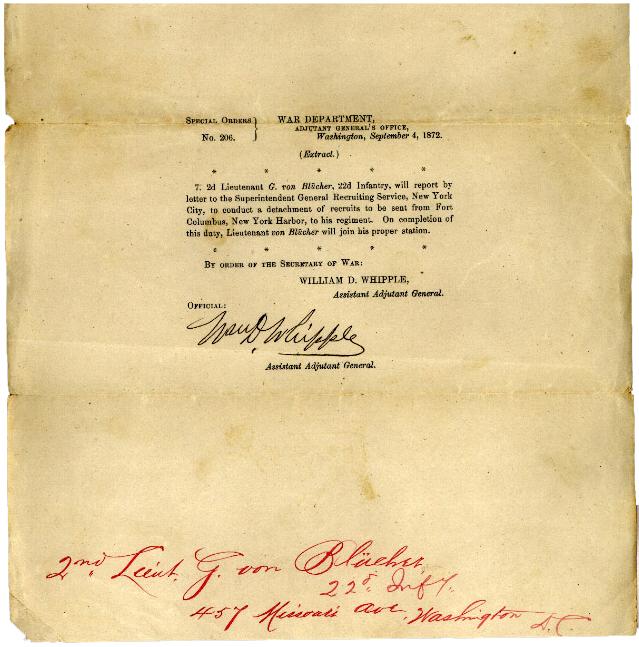
Special Orders No. 206, dated September 4,
1872
directing 2nd LT Gustav von Blücher of the 22nd Infantry to
report to New York City
to bring a detachment of recruits to join the 22nd Infantry
Regiment
in the Dakota Territory
Second Yellowstone Expedition
In July, 1872, a second expedition was
organized at Fort Rice under the command of Colonel Stanley of
the Twenty-second.
This expedition was composed of Regimental Headquarters and
Campanies D, F and G, 22nd Infantry;
Companies A, B, C, F, H and K, 8th Infantry; Companies A and F,
17th Infantry, and a small detachment of Indian Scouts.
This force left Fort Rice July 26, 1872, and
reached the mouth of Powder River August 18.
On that day Colonel Stanley and a party of his officers were
fired upon by Indians said to have been led by a chief named
Gaul.
Fortunately there were no casualties, and the Indians were
quickly driven off by troops of the expedition.
Captain Hamilton stated:
"The expedition marched from Fort Rice on July 26, arriving
at the mouth of the Powder River
on August 18. During the afternoon, General Stanley, accompanied
by several officers, parleyed with a group of Indians headed by
Gaul.
The Indians stood on the opposite side of the river. Suddenly,
one of Gaul's braves opened fire.
Our troops rallied to the spot, and the Indians beat a retreat.
We then returned back to Rice, skirmishing with hostiles twice on
the return march."*
On the way back to Cabin Creek skirmishes were
fought with the Indians at O'Fallon's Creek, August 21-22.
The command, less one company of Infantry and a detachment of
Engineers, returned to Fort Rice October 15, 1872.
On October 5, 1872, 1st Lieutenant Lewis D. Adair, 22nd Infantry,
died of wounds received in action with the Indians,
the first recorded battle casualty among officers of the
regiment.
|
Muster Roll of Company G, 22nd
Infantry, Lewis Adair would die a little over
9 months later, LT Adair was the first Officer of
the Regiment The muster roll was approved and
signed |
Third Yellowstone Expedition
In May, 1873, the third Yellowstone expedition
was organized at Fort Rice under Colonel Stanley.
The force was composed of ten troops of the 7th Cavalry; Company
C, 6th Infantry; Companies B, C, F and H, 8th Infantry;
Companies A, D, E, F, H and I, 9th Infantry; Companies A, B and
H, 17th Infantry;
and Regimental Headquarters and Companies B, E, H, I and K, 22nd
Infantry.
As on the previous expedition, a detachment of Indian Scouts was
attached.
June 20, 1873, the column left Fort Rice, and
on July 31 reached the Yellowstone River about fifteen miles from
the present town of Glendive,
proceeding to Pompey's Pillar on the left bank of the river. On
August 4, the advance guard, furnished by the 7th Cavalry,
was attacked by Indians and three casualties were inflicted,
including the Regimental Veterinarian, who was killed.
August 11 the 7th Cavalry again engaged the Indians opposite the
mouth of the Big Horn River, where Lieutenant Charles Braden, 7th
Cavalry,
was severely wounded, and Lieutenant H. H. Ketchum, Adjutant of
the 22nd Infantry, had his horse shot under him.
During the night of August 11, the battalion of the 22nd kept up
a desultory fire on the Indians, who persisted in harassing the
outposts.
The Indians were finally driven to cover by the artillery
detachment under Lieutenant Webster, 22nd Infantry, composed of
men of that regiment.
Captain Hamilton
described the journey: "On June 20, we departed Fort Rice
with a large wagon train—
arriving July 31 at the crossing of the Yellowstone about fifteen
miles above Glendive.
We advanced up the left bank of the river as far as Pompey's
Pillar—but not without opposition from the Indians.
They evidently had concluded that our surveying had gone far
enough.
"On August 4, just opposite where Fort Keogh now stands, a
band of Indians ambushed our advance guard, killing three men.
The Seventh Cavalry dashed to the attack—driving the enemy
off with heavy losses.
"A few days later, the cavalry encountered a large force of
Indians near the mouth of the Bighorn River.
A desperate fight ensued with loss of life on both sides.
However, upon approach of the infantry, the hostiles dispersed.
"That evening, the Twenty-second Regiment occupied the
advance posts. Shots were exchanged with the Indians throughout
the night
as they tried to approach the camp—probably to stampede our
horses and cattle herd.
"The following day, our artillery shelled the timber along
the banks of the Yellowstone—in order to dislodge a band of
Indians
who were evidently preparing to impede the next day's journey.*
From Pompey's Pillar the expedition marched to
the Mussel Shell River, thence to the Great Porcupine,
following the latter until the Yellowstone was again reached.
Much hardship was encountered in this unexplored country,
water was scarce, and even when found was usually filled with
impurities.
"This was entirely
new and unexplored country—and it was very difficult to
transport a large military force and wagon train
across unmapped territory. Water was the most pressing
problem—it was either alkaline, or none at all."*
Finally, on September 22, the column reached
Fort Lincoln and the companies proceeded to their respective
stations.
During this expedition a total of over twelve hundred miles was
covered by marching,
yet the command as a whole returned in the best possible physical
condition.
**********************
The following documents pertain
to Charles A. Fagan,
who served in the 22nd Infantry at least from 1868 to 1873.
Fagan was born in Cambria County, Pennsylvania in 1841.
He served as a Sergeant in the 11th Pennsylvania Reserve Infantry during the Civil War.
In 1868 he was a Lance Sergeant in Company A 22nd Infantry at Fort Sully, Dakota Territory.
Fagan served as Sergeant Major
of the 22nd Infantry in Company F and later Company I
and then as Commissary Sergeant at Fort Sully and Fort Yates,
Dakota Territory.
His enlistment records indicated
that he stood 5 feet 10 inches tall, had brown hair,
blue eyes and a light complexion.
Charles A. Fagan retired as a Commissary Sergeant on February 15, 1892. He died October 31, 1916.
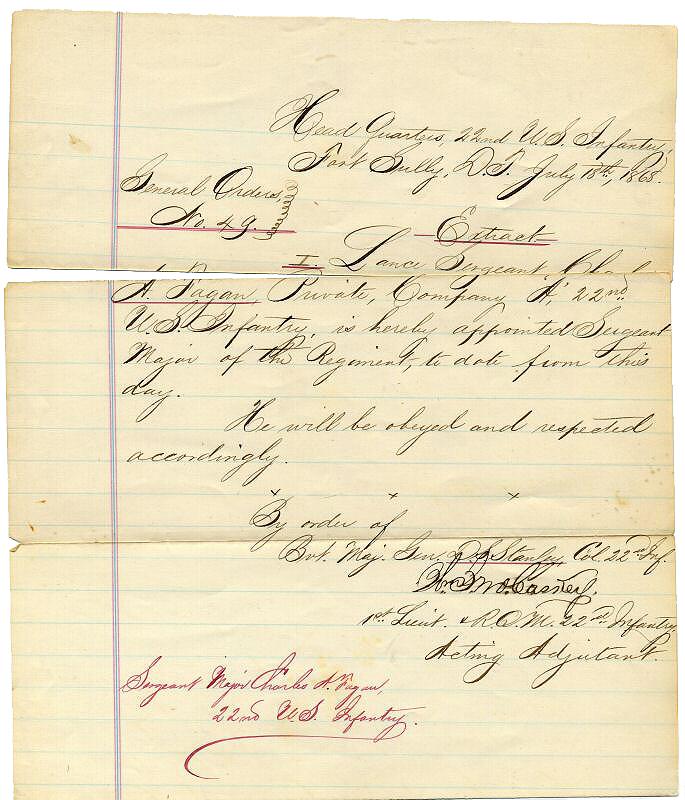
General Orders No. 49, Fort Sully,
Dakota Territory, dated July 18, 1868,
promoting Lance Sergeant Charles A. Fagan to Sergeant Major of
the Regiment.
Signing the order was 1st Lieutenant William S. McCaskey, the
Regimental Quartermaster (R.Q.M.) from
Feb 1, 1868 to July 14, 1869, in his dual role as acting Adjutant
of the Regiment.
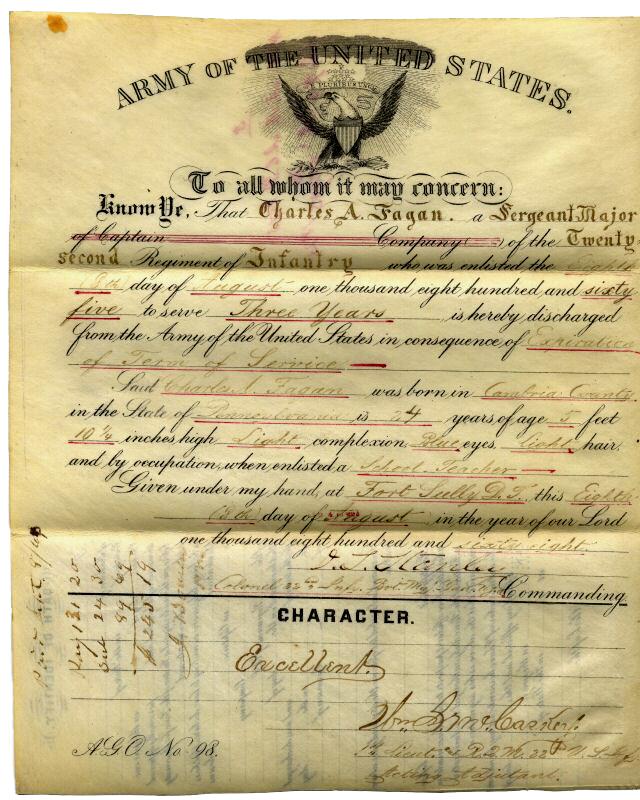
Discharge of Sgt Major Fagan, dated
August 8, 1868 at Fort Sully, D.T.
Signed by Colonel David S. Stanley (giving his rank as Colonel of
the 22nd Infantry and also as
Brevet Major General of Infantry.) Also signed by 1st LT McCaskey
as Acting Adjutant.
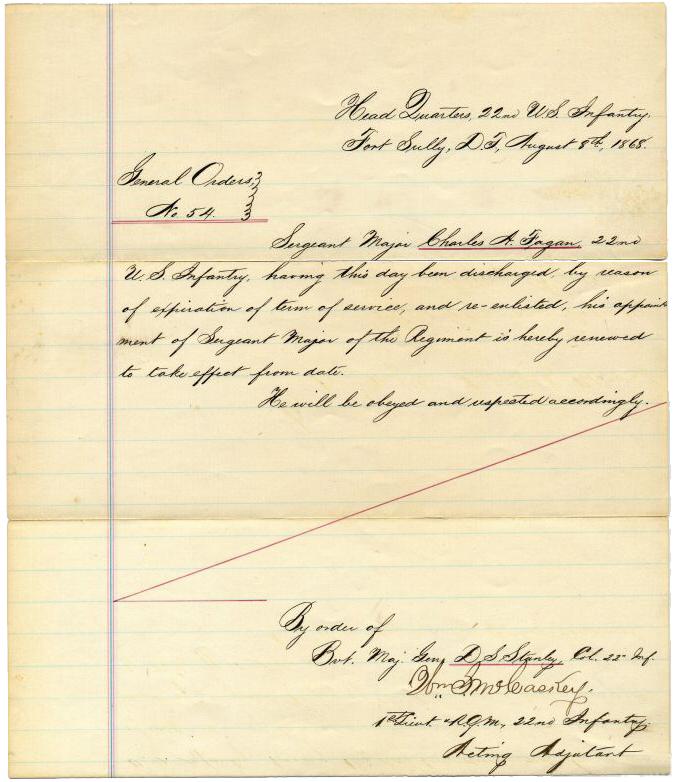
General Order No. 54, Fort Sully, D.T.
dated August 8, 1868 renewing Charles Fagan's appointment
as Sergeant Major of the Regiment upon occasion of his
re-enlistment on that date.
Signed by 1st Lieutenant William S. McCaskey.
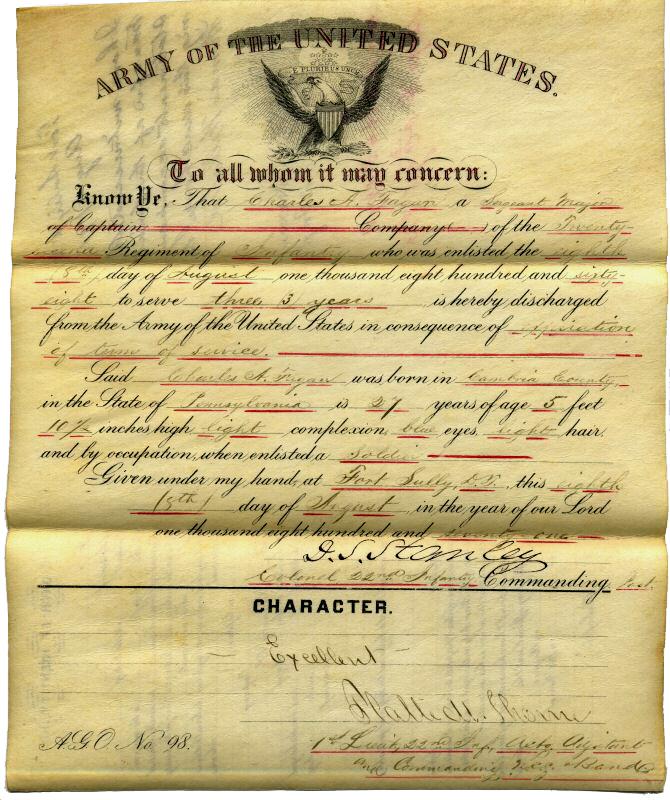
Discharge of Sgt Major Fagan, dated
August 8, 1871, at Fort Sully, D.T.
Signed by Colonel Stanley and 1st Lieutenant P.M. Thorne, who
signed as acting Adjutant.
Thorne also noted in his signature that he was the Commanding
Officer of the Regimental Band.
Captain Platt M. Thorne |
Platt M. Thorne 1LT Thorne's signature is in the above document. Thorne was appointed Captain in
the 150th New York Infantry He was commissioned a 1st
Lieutenant in the 13th Infantry He served as the Regimental
Quartermaster On March 4, 1879 he was
promoted to the rank of Captain. |
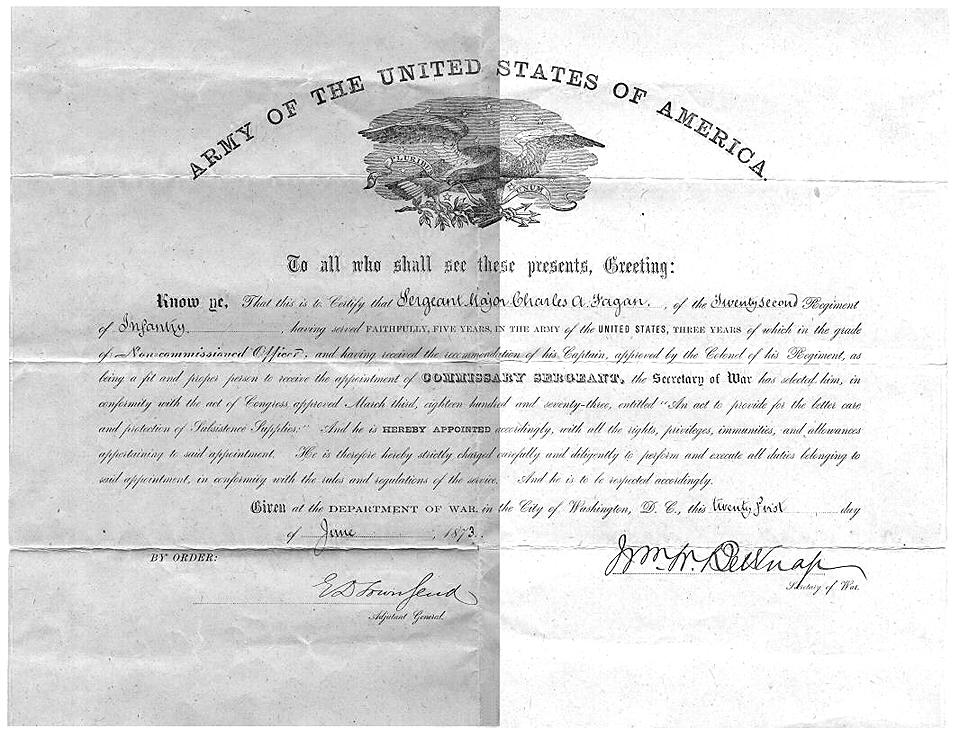
Appointment of Sgt Major Fagan of the
Twenty second Regiment of Infantry to Commissary Sergeant,
dated June 21, 1873 and signed by William W. Belknap Secretary of
War.
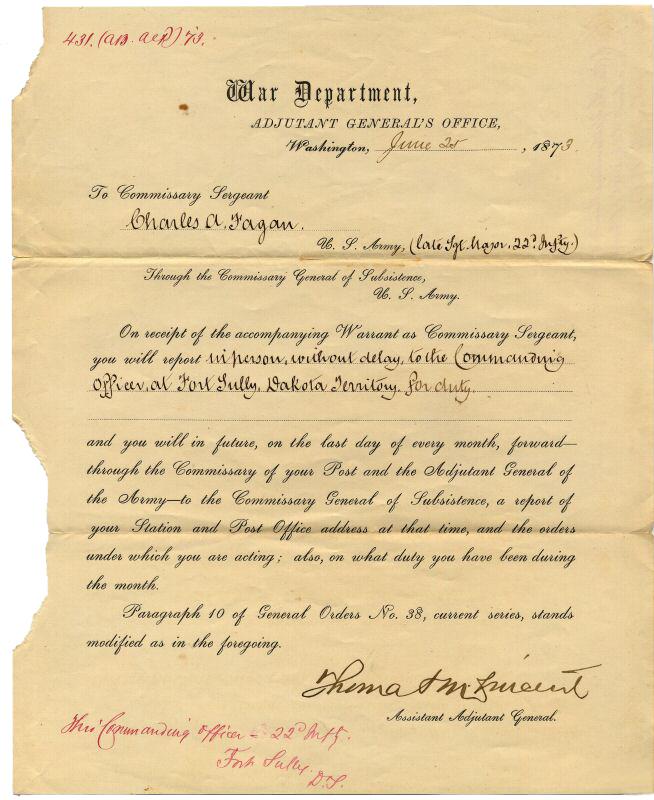
Order to Charles Fagan as Commissary
Sergeant directing him to assume his post at Fort Sully, D.T.
dated June 25, 1873.
Note Commissary Sergeant Fagan is indicated as late Sergeant
Major of the 22nd Infantry.
**********************
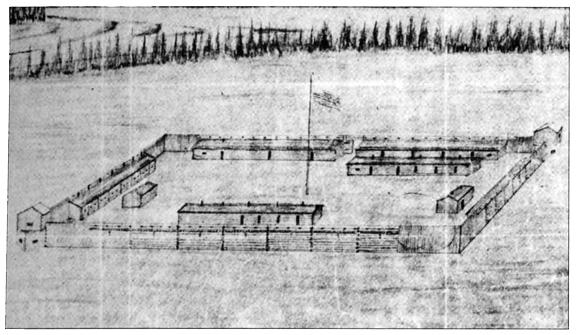
Period sketch of Fort Sully, Dakota Territory
During the years 1866 to 1873
the following losses were incurred by the 22nd Infantry.
Places of birth are listed when known.
KIA = Killed In Action
DOW = Died Of Wounds
DOD = Died Of Disease
( A catch-all phrase used in the 19th Century to denote any
non-battle death)
Headquarters:
Hiram Dryer.....03/05/1867 -
Major of the Regiment - DOD - New York - Died of pneumonia at
Fort Randall, D. T.
Steve.....10/1872 - personal servant of Regimental Commander
Colonel David S. Stanley - KIA - Killed in skirmish with hostile
Sioux on First Yellowstone Expedition
Company A
Joseph Marshall.....09/15/1867 -
Captain - DOD - Indiana - Died of chronic dysentery at Fort Rice,
D.T.
Cornelius Bowler.....08/31/1870 - Private - DOD - Derbyshire,
England - Died of pneumonia
Patrick Connor.....02/21/1873 - Corporal - DOD - Died of
inflammation of the liver
Company B
Chrispin D. Giles.....09/11/1867
- Private - KIA - Lawrence, California - Killed by Indians near
Fort Rice
David H. Conger.....11/28/1867 - Private - DOD - Luzerne,
Pennsylvania - Died of acute dysentery
James M. Coffman.....10/04/1869 - Private - DOD - Tippecanoe
County, Indiana - Died of dysentery
Francis Frazer.....08/11/1871 - Private - DOD - England - Drowned
Charles Berlinn.....08/25/1871 - Private - DOD - Germany -
Drowned
Peter Kinney.....10/19/1872 - Sergeant - DOD - Steuben, New York
- Murdered
Company C
Anson Windover.....02/08/1870
Private - DOD - Canada - Died of pneumonia
John Thompson.....02/11/1870 - Private - DOD - Buffalo, New York
- Frozen to death
August F. Neithardt.....12/30/1872 - Private - DOD - Saxonia,
Germany - Died of apoplexy
Company D
John Martin.....06/28/1867 -
Private - DOD - New York, New York - Drowned
Jacob Luchsinger.....12/22/1867 - Corporal - DOD - Dubuque, Iowa
- Died of appendicitis at Fort Dakota, Dakota Territory
Robert Allen.....11/19/1870 - Private - DOD - Limmerick, Ireland
- Died of retention of urine at Fort Randall, Dakota Territory
Company E
William Burke.....01/16/1870 - Private - DOD - Accidentally shot by his own hands
Company F
Gustav Hartwig.....02/06/1867 -
Private - DOD - Drowned in Missouri River
John Miller.....07/11/1867 - Private - DOD - Ripley, Illinois -
Died of acute hepatitis
Robert A. Gibson.....09/23/1867 - 2nd Lieutenant - DOD -
Pennsylvania - Suicide
Elias Huston Prall.....03/16/1869 - Private - KIA - Clark County,
Indiana - Killed by Indians near Fort Randall, Dakota Territory
Daniel Daily.....02/01/1871 - Private - DOD - Cork, Ireland -
Died of consumption
Company G
James Crowe.....07/28/1867 -
Private - DOD - Kilkenny, Ireland - Drowned while bathing in
Missouri River near Fort Sully, Dakota Territory
Andrew J. Hynes.....07/28/1867 - Private - DOD - Drowned in
Missouri River near Fort Sully, Dakota Territory
Timothy Lannon.....08/12/1870 - Private - DOD - Limerick, Ireland
- Drowned in Missouri River
James B. Gray.....04/04/1871 - Sergeant - DOD - Accidentally shot
Laurence Nugent.....06/28/1871 - Private - DOD - Louth County,
Ireland - Died of gun shot wound at his own hand
William Douglas.....09/15/1871 - Private - DOD - Died of acute
dysentery
Lewis Dent Adair.....10/05/1872 - 1st Lieutenant - DOW - Scioto,
Ohio - Died of wounds received in action against Sioux near Heart
River Crossing
Company H
Patrick Pender.....11/15/1870 - Private - DOD - Ireland - Murdered
Company I
Samuel Raney.....08/22/1867 -
Private - DOD - Ireland - Died of gun shot wound at Fort Rice
Henry Warrington.....08/22/1867 - Private - DOD -
Huntingdonshire, England - Died of heart disease
Ernst Zimmer.....05/10/1868 - Private - DOD - Germany - Drowned
in Missouri River
John T. Vane.....09/28/1868 - Private - KIA - Jersey City, New
Jersey - Killed by hostile Indians near Fort Rice
John W. Robinson.....02/16/1870 - Private - DOD - Evansville,
Kentucky - Died of bronchitis
Henry Bales.....09/01/1870 - Private - DOD - England - Died of
inflammation of the stomach
Company K
James McCabe.....09/08/1867 -
Private - DOD - Cork, Ireland - Died of chronic diarrhea
Michael Dowd.....09/11/1867 - Private - DOD - Galway County,
Ireland - Died of dysentery
Jeremiah Conway.....12/18/1867 - Corporal - DOD - Ireland - Died
of inflammation of the brain
James Frazer.....11/08/1870 - Private - DOD - Scotland - Died of
Kidney disease
William Shields.....11/20/1870 - Private - DOD - Pittsburg,
Pennsylvania - Died of Acute Apoplexy
Paul Ott.....10/01/1872 - Private - DOD - Died of peritonitis
**********************
Much of the above text was transcribed from the official Regimental History, written in 1904 and updated in 1922.
Additional material added by the website editor
Additional information taken from:
Returns from Regular Army Infantry
Regiments, June 1821–December 1916. NARA
microfilm publication M665
National Archives and Records Administration, Washington, D.C.
Historical Register and Dictionary of the
United States Army
from its organization September 29, 1789 to March 2, 1903 by
Francis B. Heitman
Washington, Government Printing Office 1903
Passages marked by * were taken from:
Combat Diary EPISODES FROM THE HISTORY OF THE
TWENTY-SECOND REGIMENT, 1866-1905 by A. B. Feuer,
Praeger Publishers, One Madison Avenue, New York, NY 10010
From:
All material used with permission of the author.
Home | Photos | Battles & History | Current |
Rosters & Reports | Medal of Honor | Killed
in Action |
Personnel Locator | Commanders | Station
List | Campaigns |
Honors | Insignia & Memorabilia | 4-42
Artillery | Taps |
What's New | Editorial | Links |